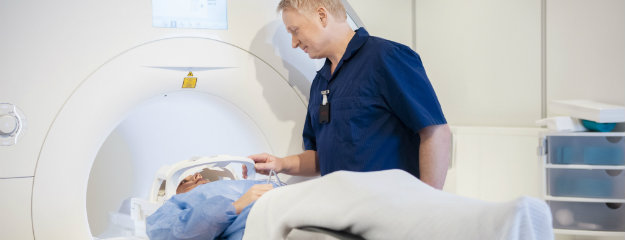If you or a loved one suffers a stroke, your doctor may recommend that you make an appointment at an imaging center for a brain MRI. The images from this scan help your medical team to see where the stroke damaged the brain and the extent of the damage. Here’s what to expect with an MRI of the brain.
How Do Brain MRIs Work?
During a brain MRI, the MRI machine creates a magnetic field. This changes the water molecules in your brain, and as those molecules respond to the magnetic field, it creates an image. Your physician uses those images to draw all kinds of conclusions about what’s happening with your brain.
What Is the Difference Between a Brain MRI and a CT Scan?
CT scans are useful in a number of different situations, but CT scans are more useful for imaging bone and soft tissues. They can’t create the detailed images that a brain MRI can. Additionally, a brain MRI can scan all areas of the brain and take images from multiple angles, which is especially helpful when assessing water damage after a stroke. In a lot of cases, strokes can damage whole sides of the brain, but in other cases, the damage may be restricted to a small area.
What Happens During a Brain MRI?
Before the MRI scan begins, please remove all jewelry and metal objects. If you have permanent metal objects in your body such as aneurysm clips, talk with your physician or the technologist doing the imaging. In some cases, MRIs use special dyes to create the images. If your physician is using dyes, you will need a small injection before the process starts.
Usually, you lie down on the table for the brain MRI. Then, the technologist places a surface of the part that should be much brighter with the help of a coil around your head. That is a special radio antenna. At this point, the technologist leaves the room, but you can communicate with them via an intercom in the MRI machine.
During the brain MRI, you have to lie still. The scan typically takes between 30 and 90 minutes to complete, but you can often opt to listen to music, an audiobook, or a podcast during the procedure. That helps many patients relax. Please note that you may hear some knocking noises during the scan.
What Are the Risks of an MRI Brain Scan?
Fortunately, there are no serious side effects associated with an MRI. An MRI does not involve X-rays, so you don’t have to worry about radiation. The only potential risk is the danger of interactions if you have metal implants or devices in your body, but as long as you discuss this with your doctor beforehand, you should be fine. Finally, if you are severely claustrophobic, you may have issues with the setup of the MRI, and again, you should talk with your healthcare provider before you get started.
If you’ve had a stroke, you may need an MRI. Contact American Health Imaging to schedule an MRI today. If you’re a doctor treating a patient who has recently had a stroke, you can also arrange an MRI with us.
